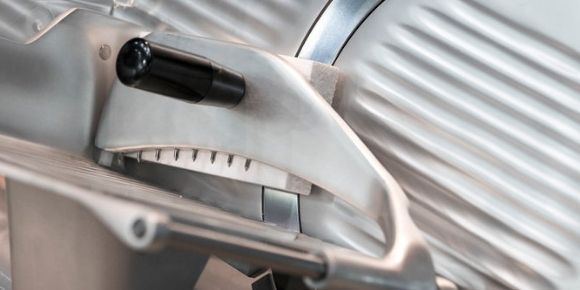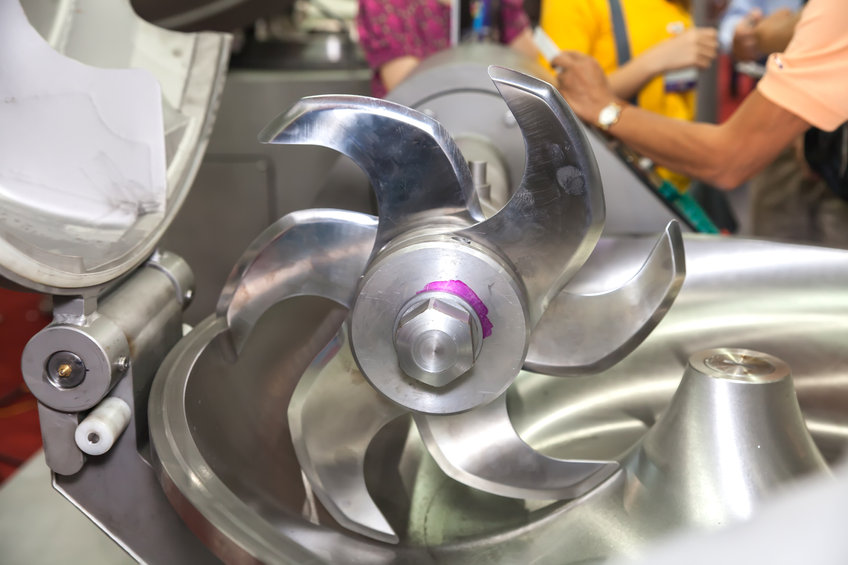

Meat slicers are some of the most active machines in a commercial kitchen. Being the workhorses of the food preparation process, they’re essential to chopping up meats, cheese, and even produce. However, since these machines are used so frequently in the food business, there tends to be a quick build-up of food residue and oils. From small particles to large deposits, the deposition of residue can quickly turn into a major health hazard. These deposits can be colonized by harmful bacteria and can cause a range of infectious diseases.
Meat slicers are required to be cleaned at least once every four hours at busy establishments due to the sheer volume of activity in these businesses. Knowing how to clean a meat slicer also enhances the lifespan of your unit, and ensures you get great cuts of meat. Cleaning a meat slicer is one of the daily activities your staff must undertake so you run a safe, sanitary, and responsible operation. We discuss simple and effective ways to clean meat slicers at your establishment in the sections below.
The Importance of Cleaning Meat Slicers & Their Maintenance
Meat slicers are some of the most heavily used pieces of equipment in a commercial kitchen. Cleaning meat slicers is essential to the removal of food soil and residue that act as perfect breeding grounds for harmful strains of bacteria. Not cleaning meat slicers at your commercial kitchen can lead to serious cases of food poisoning in your patrons. It’s also essential that you understand how to clean a meat slicer so you can also prevent the transfer of different flavors across different dishes. The microparticles left behind on the meat slicer blades are capable of ruining the well-crafted taste profile of your dishes. Regular maintenance and cleaning of meat slicers are also essential food safety practices recommended by most food safety and health authorities.
Understanding the Meat Slicer & Its Parts
A meat slicer is a complex machine that comes with a variety of parts. While some parts are easy to clean, some of them are tougher to reach and come with a higher risk of bacterial contamination. Common parts in an average meat slicer include the slicer blade, handle, blade guard, and ring guard. The meat slicer also comes with a variety of seals and gaskets that are meant to keep the unit together. It’s important to examine all of these parts for any breaks and cracks since they can harbor harmful bacteria. Any broken portion of the unit must be replaced before cleaning and sanitizing a meat slicer. Meat slicers with broken parts and seals are major safety hazards and pose a threat even to your employees. Ensure regular cleaning and maintenance is an integral part of your establishment’s schedule to prevent contamination and workplace injuries resulting from meat slicers.
Important Points to Remember before Cleaning & Sanitizing a Meat Slicer
So, what should an employee do before cleaning a meat slicer? Here are some important tips and points to remember:
- Ensure your staff wears personal protective clothing such as cut-resistant gloves before they clean the slicer blades and the sharp parts of the unit.
- Be sure to provide the instruction manual and manufacturer’s recommendations to the employees who clean the meat slicer.
- Once the slicer is dismantled, instruct your employees to segregate the parts that are dishwasher-safe and those that aren’t.
- Avoid using abrasive brushes and tools to clean the meat slicer as these might end up scratching the surface of the blade and other parts of the unit.
Simple Steps to Follow When Cleaning a Meat Slicer
While certain portions of the instructions might differ from the recommendations provided by the manufacturer, most of the tips remain common to available meat slicer models. Keep your instructions manual close by for reference when cleaning your meat slicer. The correct order of operations to clean a meat slicer are:
- Disconnect your meat slicer from the power source once you are done using it. Ensure the power cable is kept away from the cleaning agents. Make sure you and your employees wear cut-proof gloves before you get down to cleaning the meat slicer.
- Set the knob of the meat slicer to zero to enable you to remove the blade from the unit. Along with the blade, also remove the blade guard, ring guard, the food chute, the deflector, and the blade sharpener in case it is mounted along with the unit. While these instructions apply to electric models, you can use a blade removal tool to detach the blade from manual meat slicers.
- After you have removed the blade and the other parts of the meat slicer, scrub off the large residues stuck to the blade using a scrubbing pad or a brush. Check all the parts, and clean them thoroughly. For inaccessible areas, you can use a smaller cleaning tool like a toothbrush.
- Prepare a dilute detergent solution once you are done scrubbing the parts of the meat slicer. The detergent solution will help you remove stubborn deposits the initial scrub failed to clear. You can mix regular dish soap with warm water. The ratio is often one part of dish soap to a part of water.
- Use the detergent solution to clean the parts of the meat slicer by wiping them down using a scrub pad or a cloth. In case your meat slicer has parts that are dishwasher friendly, you can load those parts of the meat slicer into your dishwasher to clean them thoroughly. For those parts that cannot be cleaned in a dishwasher, use the first method of wiping down with a cloth.
- In case the blade is especially greasy, you can use a degreaser spray to get rid of all the residue.
- Make sure you’re meticulous with the cleaning and get to all the portions where you might expect bacterial colonies to thrive.
- Once cleaned, allow all the parts to air dry, or pat them dry using a clean cloth.
- After cleaning the meat slicer, you can proceed to sanitize the meat slicer and its parts. Sanitization is essential to make the unit capable of safely operating based on the food authorities’ standards. The sanitizer fluid kills most of the microbes and ensures all the remaining bacterial colonies that survived the cleaning process are destroyed.
- Using a meat slicer sanitizing spray is ideal as the aerosol spray ensures the sanitizer solution gets to all parts of the machine.
- After having sanitized the meat slicer and its parts, allow all of the sanitized portions to air dry. Remember not to wash the meat slicer after sanitizing it.
- In case you notice wear and tear on parts of the meat slicer, spray some food-grade lubricant to ensure smooth functioning. Avoid using cooking oil as a lubricant for the meat slicer.
- Following the lubrication of the machine, reassemble all parts of the meat slicer and set it aside for use at the food prep bay.
- In case you notice parts of the meat slicer that are too worn or broken, replace them with spares, or consider purchasing a new food slicer for your establishment.
Since meat slicers go through such a high volume of food every day, it is integral that your employees understand how to clean a meat slicer with precision. Avoiding regular cleaning cycles also exposes your unit to rust and corrosion - a factor that prevents your meat slicer from serving through its complete operational lifespan. It’s also important to outfit your kitchen with quality commercial kitchen equipment so you can rely on trustworthy machines. While your food prep bay can be managed by reliable food slicers and processors, secure your produce with high-grade walk-in units and other cold storage solutions for your establishment.








